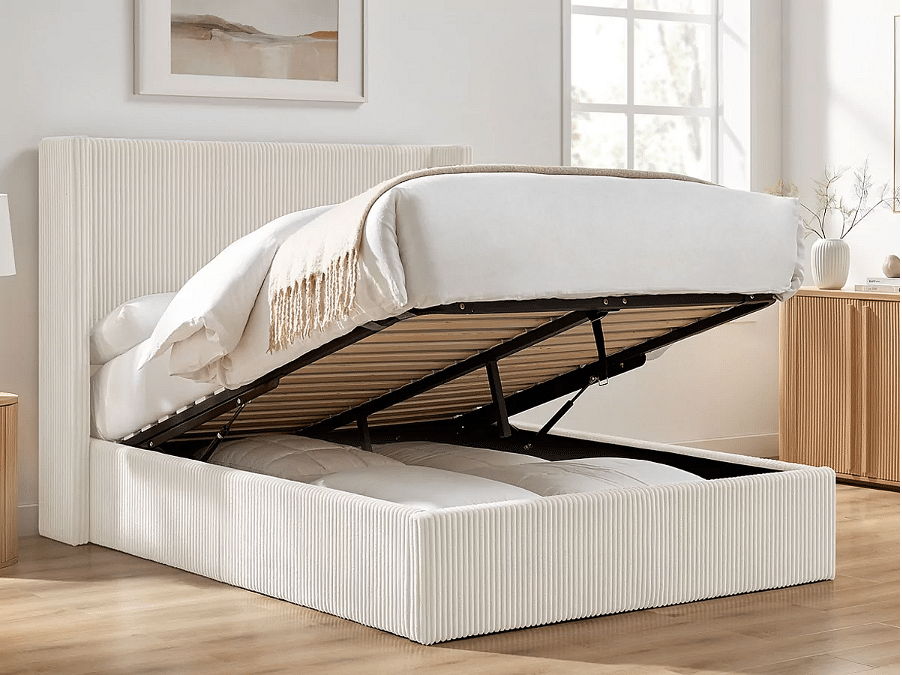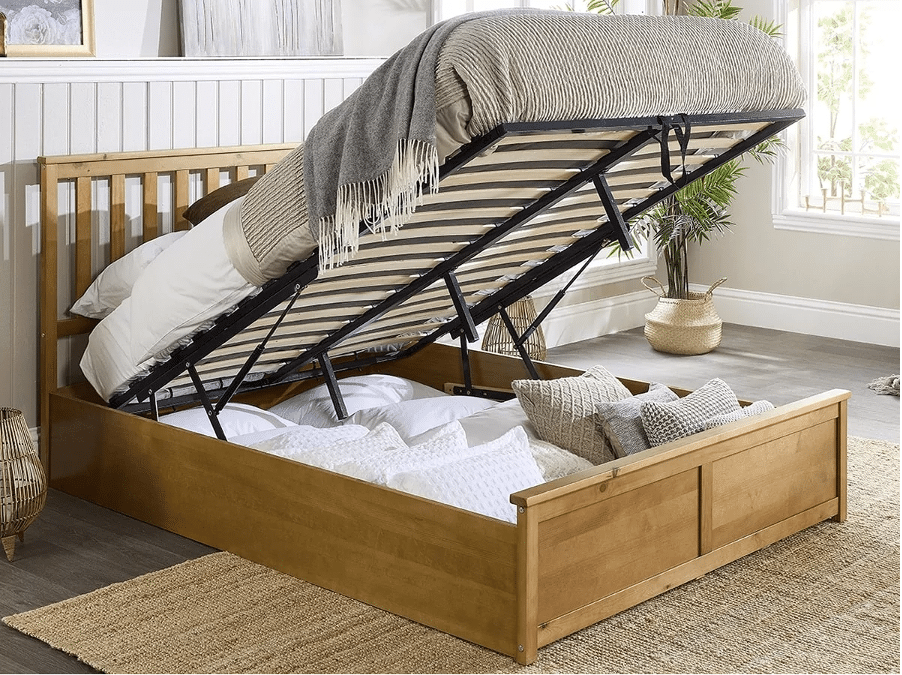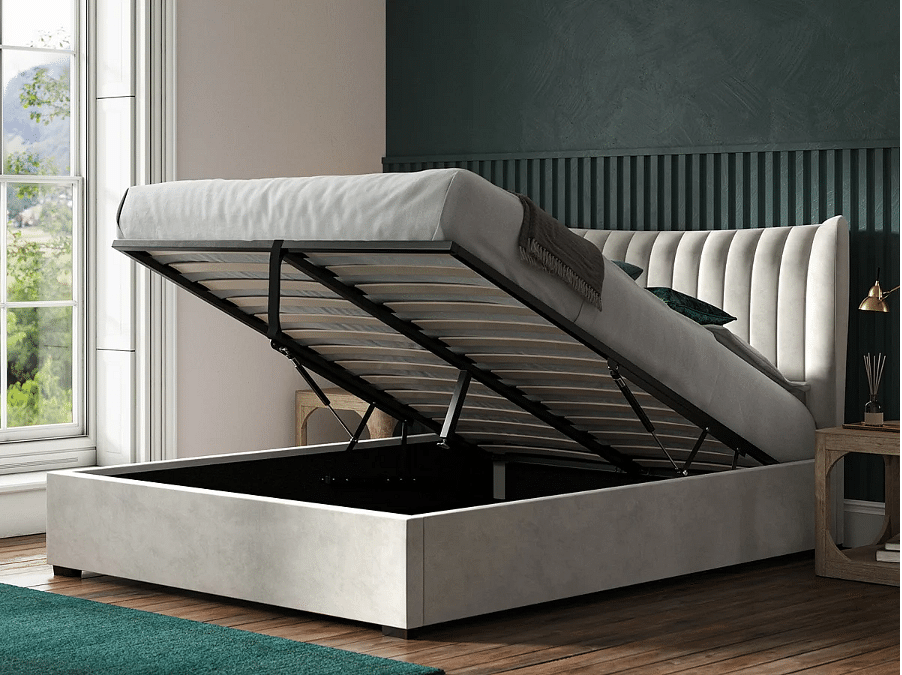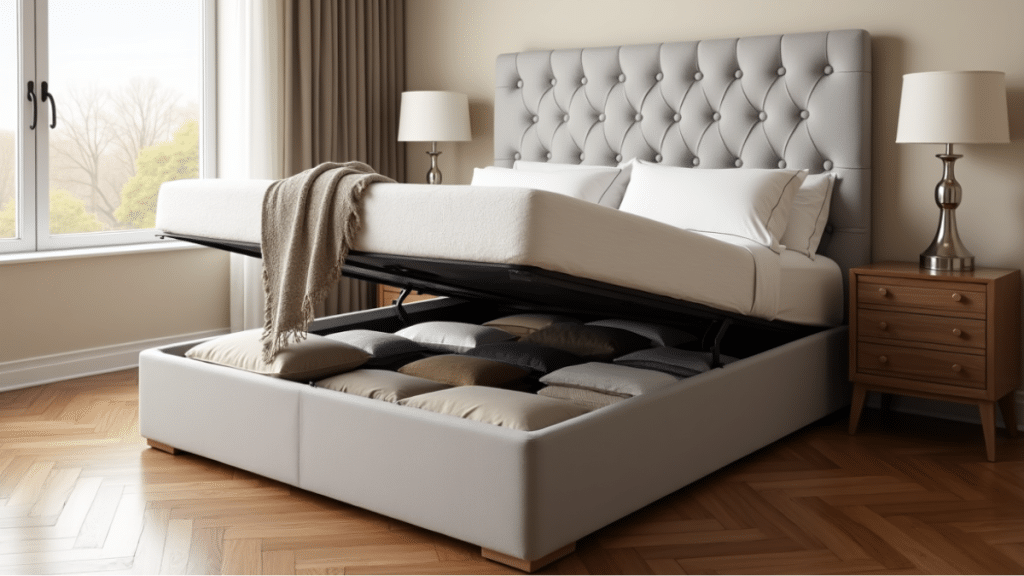Ottoman beds have come a long way since their origins in the 13th century Ottoman Empire. Today, they’re changing how we think about bedroom storage with their clever design and practical benefits.
Looking for something that traditional drawer beds just can’t offer? Ottoman beds give you complete access to the entire under-mattress space through their handy gas-lift hydraulics. It’s like having a secret room under your bed!
Your bedroom should be your own personal sanctuary, especially when space is tight. That’s where ottoman beds really shine. They use every inch beneath your mattress for storage, giving you so much more space than regular beds with drawers. Their sturdy build means they can handle more weight too – perfect for tucking away those winter duvets, extra bedding, and all those bits and pieces you need but don’t want on display.
Why choose an ottoman bed? Simply put, they’re one of the easiest ways to add tons of hidden storage without taking up any extra floor space in your bedroom. We’ve looked at all the options out there to help you pick the perfect one for your needs. Let’s explore how an ottoman bed could be the bedroom storage hero you’ve been dreaming about!
What Are Ottoman Beds: Features and Functionality (2025)
An ottoman bed is completely different from your standard bed frame thanks to its clever built-in storage system beneath the mattress. Instead of wasted space or those awkward gaps under regular beds, these practical pieces give you hidden, easy-to-access storage while keeping your bedroom looking stylish.
Gas-Lift Mechanism: How Ottoman Beds Work
At the heart of every ottoman bed is the gas-lift hydraulic system – it’s the same clever technology that helps your car’s boot open smoothly. These beds have gas pistons (usually one on each side) that look a bit like bike pumps. When you lift the bed platform, these cylinders do the hard work by supporting both your mattress and frame.
Inside each piston, there’s a special mix of gas and oil working together – the gas stores the energy while the oil keeps everything moving smoothly. This clever mechanism does three important jobs:
- It makes lifting your heavy mattress much easier
- It holds the platform steady while you’re getting things in and out
- It ensures the bed closes gently, so it won’t slam shut
Quality ottoman beds typically use 800-Newton gas struts – that’s about the force they can handle safely. This detail really matters because poor-quality struts can be dangerous – if they’re too weak, the bed might unexpectedly slam shut while you’re reaching for something.

Pictured: Limelight Gemini Ottoman Bed – Natural Cord. Priced £499 (Bedstar)
Storage Capacity: What Can You Fit Inside?
The biggest advantage of ottoman beds over beds with drawers is their huge, uninterrupted storage space. Unlike divan beds with separate drawers, ottoman beds let you access the entire area under your mattress, making them perfect for storing:
- Seasonal clothing and bedding
- Extra pillows and duvets
- Towels and linens
- Books and keepsakes
- Shoes and accessories
- Suitcases and travel gear
Ottoman beds are absolutely brilliant for smaller rooms where every inch counts. With a bit of organisation, you can neatly store away items that would otherwise need extra furniture like dressers or wardrobes.
Takeaway Tip: Use vacuum storage bags to compress bulky items like winter duvets, making even more of your ottoman bed’s storage space.
It’s worth noting there are weight limits to keep in mind. Most manufacturers will tell you the maximum storage weight for their ottoman beds. Going over this limit might damage the lifting mechanism or create safety risks. As a guide, good quality ottoman beds can usually support mattresses weighing up to 85kg.
Types of Ottoman Beds: Side-Opening vs. End-Opening
Ottoman beds come in two main types, each designed for different room layouts and how you’ll need to access your things:
End-Opening Ottoman Beds These lift from the foot of the bed, giving you storage access from the bottom end. They’re your best bet when:
- Your bed sits in the middle of the room (not pushed against side walls)
- Only the headboard touches a wall
- You want to access the full width of storage space
Side-Opening Ottoman Beds These lift from either the left or right side. They’re ideal when:
- Your bed is pushed against a wall
- You don’t have much space on one side
- You find it easier to access storage from a seated position
Which one you choose really depends on your bedroom layout. For corner placement, the end-opening designs usually work better. Side-opening models are great for beds placed against walls, as they can open fully without hitting anything.
Both types give you exactly the same amount of storage and use the same gas-lift mechanism. The only difference is the direction they open and how you’ll interact with the bed in your space.
Choosing the Right Ottoman Bed Size for Your Space
Finding the perfect ottoman bed size means thinking about both your storage needs AND your available bedroom space. Each size comes with different storage possibilities while fitting different room sizes and sleeping arrangements. Let’s look at which ottoman bed size might be your perfect match.
Single Ottoman Beds: Compact Storage Solutions
Single ottoman beds measure 3′ x 6’3″ (90 x 190cm), making them ideal for children’s bedrooms, guest rooms, or adult bedrooms where space is tight. Don’t be fooled by their smaller size – these beds still offer plenty of storage underneath the mattress. With storage depth typically reaching around 24cm, you’ll have loads of room for seasonal clothing, extra bedding, or children’s toys.
For REALLY tight spaces, some manufacturers even make small single ottoman beds measuring just 2’6″ wide. These come with the same clever gas-assisted lift mechanism as their bigger brothers and sisters. These compact beds are absolutely brilliant in box rooms where every inch of space counts!
Double Ottoman Beds: Balancing Space and Storage
Double ottoman beds measure 4’6″ x 6’3″ (135 x 190cm) and are the most popular choice for couples sharing a bedroom. This size hits that sweet spot between comfortable sleeping space for two adults while still fitting nicely in standard bedrooms.
As you’d expect, the storage space grows with the bed size, making double ottoman beds especially valuable in master bedrooms where storage needs tend to be greater. Many couples find that by upgrading to a double ottoman bed, they can actually get rid of extra furniture like free-standing drawers – freeing up precious floor space in your bedroom sanctuary.
King Size Ottoman Beds: Maximizing Storage Potential
Looking for the MAXIMUM storage capacity? King size ottoman beds are your answer. Measuring 5′ x 6’6″ (150 x 200cm), these beds give you an extra 10cm in length and 15cm in width compared to standard doubles. This bigger surface area means substantially more storage space underneath.
The entire area beneath a king size ottoman bed is yours for storage, creating a huge space for bulkier items like suitcases, winter duvets, or those summer clothes during colder months. Plus, the wider sleeping surface gives couples more personal space – especially helpful if you share your bed with children or pets!
Takeaway Tip: Check that your king size mattress isn’t thicker than 32cm, as this can interfere with the ottoman mechanism or cause squishing against the headboard.
Small Double Ottoman Beds: Perfect for Guest Rooms
Small double ottoman beds (4′ x 6’3″ or 120 x 190cm) sit in that handy middle ground between single and standard double sizes. This in-between size works wonderfully for guest rooms or smaller master bedrooms where making the most of space really matters.
Though not as roomy as a standard double, these beds can still fit two adults – just with a bit less personal space than a standard double offers. For single sleepers wanting extra room to stretch out without losing valuable floor space, a small double ottoman is the perfect compromise. And the storage space is still impressive – typically featuring a 42cm deep storage area across the bed’s width and length.
Small double ottoman beds really shine in rooms that need to multi-task, like home offices or craft rooms that sometimes need to welcome overnight guests. Their modest size paired with generous storage makes them perfect for those versatile spaces where every square foot is precious.
Whichever size you choose, remember that ottoman beds need some space to actually open – especially side-opening models that need room alongside the bed for the lifting mechanism to work properly. Your bedroom should be your own personal sanctuary, and choosing the right size ottoman bed is key to creating that perfect balance of sleep space and storage.
Ottoman Bed Materials and Construction Quality
How your ottoman bed looks and lasts depends hugely on what it’s made from. Understanding these different materials helps you pick a bed that’s not just pretty, but practical too.
Frame Materials: Wood vs. Metal Options
Wood frames are a favourite choice for ottoman beds, bringing natural warmth and excellent stability to your bedroom. Oak frames offer amazing durability and stand up well to moisture, while pine gives you a lighter, more budget-friendly option. Looking for something a bit special? Mahogany frames show off rich, deep colours, and walnut brings sophisticated looks with outstanding staying power.
Metal frames are worth considering too, especially if you’re watching your budget or need something easier to move:
- Steel: Giving you a strong structure in lots of different finishes
- Iron: Offering strength that can be shaped into decorative designs
- Aluminum: Providing lightweight construction that won’t rust
Wooden frames win on stability because of their weight – they’re less likely to shift around or make annoying creaking noises. Metal frames, on the other hand, might develop squeaks over time if they’re not put together properly or looked after.
Takeaway Tip: If you choose a metal frame, check and tighten the fittings every few months to prevent those middle-of-the-night creaks!

Pictured: Timberland Wooden Ottoman Bed – Natural. Priced £299 (Bedstar)
Upholstery Choices: Fabric, Leather, and Alternatives
What’s on the outside of your ottoman bed affects both how it looks and how long it lasts. Fabric upholstery creates a softer, cosier bedroom look with endless colour and pattern options. Linen gives you breathability with a casual feel, while velvet delivers plush luxury with amazing depth.
Fancy something more sophisticated? Leather and faux leather add a slick, modern appeal to your bedroom sanctuary. Real leather gives exceptional durability that actually gets better with age, though you’ll need to look after it properly to avoid scratches and fading. Leather ottoman beds are naturally hypoallergenic too – great news if you suffer from allergies!
For something more on-trend, why not try chenille, plush velvet, or boucle fabrics? These offer distinctive textures that add visual interest to your bedroom space.
Base Construction and Weight Capacity
The secret to a quality ottoman bed lies in how well it’s built. The best ottomans feature solid corner-jointed boxes, ideally made from substantial veneered MDF, which gives exceptional strength through its layered construction. These are then lined with either stitchbond (thick woven plastic coating) or hessian (more breathable and tough).
How much weight can your ottoman bed handle? It’s an important question! Standard ottoman beds typically support between 200-300kg including your mattress and yourself, though specially reinforced models can handle up to 450kg of storage weight. The gas struts or pistons are without doubt the most important part – quality models have struts designed to lift mattresses weighing 40-60kg, with heavy-duty options supporting up to 100kg.
A well-made ottoman bed should last around 10 years with proper care, especially when it has non-slip top covers that stop your mattress sliding about when you’re opening and closing the storage area.
Your bedroom should be your own personal sanctuary, and the quality of your ottoman bed’s construction plays a huge part in creating that perfect sleep space. Choose wisely, and you’ll enjoy both comfort and convenience for years to come!
Setting Up Your Ottoman Bed: Assembly and Placement
Getting your new ottoman bed set up properly means you’ll enjoy both its comfort and clever storage for years to come. With the right approach to putting it together and finding its perfect spot in your room, you’ll make the most of your new bed while avoiding any headaches along the way.
Step-by-Step Assembly Guide
Good news! Most ottoman beds arrive partially pre-assembled with the gas lift mechanisms already fitted to make your life easier. For standard ottoman beds, you’ll typically spend between twenty minutes to an hour putting everything together, depending on how complex the design is and how handy you are with DIY projects.
Here’s how to get your ottoman bed ready for action:
- Unpack everything and get to know all the parts before you start
- Click the chrome legs into each base unit (they usually lock in with a firm tap)
- Line up the two pre-assembled base units and connect them using the U-clips provided
- Attach the headboard using the bolts and washers in the box (usually two bolts for each side)
- Connect the lids together using the supplied fasteners (look for small tears in both lids showing where screws should go)
- Finally, secure the gas pistons to the lids if they aren’t already attached
Takeaway Tip: This job is MUCH easier with two people, especially when handling the heavier bits and making sure everything lines up properly. Don’t try to be a hero – get someone to help!
Positioning for Optimal Access
Where you place your ottoman bed directly affects how easily you can get to all that lovely storage space inside. For side-opening models, make sure you’ve got enough space on the opening side so the mechanism can work without bumping into anything. End-lift designs work best when only the headboard is against a wall, giving you full access from the foot of the bed.
If you’re putting your bed in a corner, end-opening designs usually give you better access. Also, don’t forget to think about the height of your ceiling if you’re placing the bed under sloped roofs – you’ll need enough vertical space when the storage compartment is fully open.
Adding Your Mattress: Compatibility Considerations
Did you know the weight of your mattress has a big impact on how easily you can open and close your ottoman bed? Most standard ottoman beds can handle mattresses weighing up to 90kg, though reinforced models with upgraded gas pistons can support heavier options up to 125kg.
Before you choose a mattress, check your bed’s specific weight limit. Too heavy, and you’ll strain the lifting mechanism, making it hard to open or potentially causing damage over time. On the flip side, mattresses that are too light might make the lifting mechanism pop up unexpectedly fast – not what you want when you’re just trying to make your bed!
Some mattresses tend to slide around on ottoman beds, especially those with smooth covers. It’s frustrating when you open your bed and your mattress shifts all over the place! To prevent this annoying problem, look for ottoman beds with anti-slip platform tops that help keep your mattress firmly in place during operation.
Your bedroom should be your own personal sanctuary, and a properly set-up ottoman bed adds both style and function to your space. With these tips, you’ll be enjoying all the benefits of your smart storage bed in no time!
Maintaining Your Ottoman Bed for Longevity
Looking after your ottoman bed properly means it’ll stay looking great and working perfectly throughout its 10-15 year lifespan. With a bit of regular TLC, these clever storage beds will keep operating smoothly year after year.
Cleaning Different Ottoman Bed Materials
How you clean your ottoman bed depends entirely on what it’s made from. Got a wooden frame? Use a wood-friendly polish to keep it shining and protected—but do check that your cleaning products won’t damage the finish. Fabric upholstery needs gentler handling; stick to lukewarm water and a white cloth to avoid any colour transfer or staining.
If you’ve chosen a luxurious velvet ottoman bed, use a soft-bristle brush after cleaning to restore the nap and keep that plush texture looking its best. Don’t forget about the inside storage area—it needs a good clean at least once every three months. Empty everything out, wipe all surfaces with a gentle, non-abrasive cleaner, and give it a thorough vacuum before putting your things back.
Takeaway Tip: Store your items in vacuum-sealed bags or airtight containers to cut down on dust build-up and make future cleaning so much easier!

Pictured: Harcourt Ottoman Bed Frame – Light Grey. Priced £639 (Bedstar)
Hydraulic Mechanism Maintenance
The gas-powered lift mechanism is the heart of your ottoman bed—it’s what makes all that clever storage actually work! To keep it running smoothly:
- Check the pistons regularly for any stiffness or damage
- Use silicone-based lubricant on moving parts (never go for oil-based products)
- Keep an eye on all the screws, bolts and hinges, tightening them up when needed
Hearing squeaks when you open or close your bed? That’s usually a sign that some parts need lubricating. Apply a little silicone lubricant to the pivot points and hinges, but be careful to wipe away any excess so it doesn’t end up on your bedding. The great thing about ottoman beds is that if the gas pistons do wear out, you can just replace them rather than buying a whole new bed!
When to Replace Parts vs. Buy New
With proper care, a good quality ottoman bed should last 10-15 years. Usually, the hydraulic lift mechanism is the first thing to show signs of wear and tear. The good news? Replacement pistons are easy to find when the mechanism gets stiff or struggles to hold up your mattress.
Watch out for these signs that your bed needs repair rather than replacement:
- It’s becoming difficult to lift or close the bed
- The lifting is uneven (one side rises higher than the other)
- You hear strange noises during operation
For minor problems, professional repair services can diagnose and fix issues effectively. But if your bed frame has significant structural damage, or if repair costs are getting close to replacement price, it might make more sense economically to invest in a new ottoman bed.
Takeaway Tip: Always stick to the manufacturer’s weight capacity recommendations—overloading your storage space will damage both the bed frame and lifting mechanism over time!
Your bedroom should be your own personal sanctuary, and keeping your ottoman bed in tip-top condition is key to maintaining that perfect balance of style and function. With these simple maintenance steps, you’ll ensure your smart storage solution stays working perfectly for years to come.
Conclusion
Ottoman beds really do stand out as practical storage solutions that make perfect sense for modern homes. Their clever design gives you both a comfy night’s sleep AND generous storage space underneath, making them especially valuable if you’re tight on space. Having looked at all the options out there and tried many ourselves, we can confidently say these beds offer huge advantages over traditional storage beds.
With the option to choose between side-opening and end-opening designs, plus the various sizes available, ottoman beds can work brilliantly in almost any bedroom layout. Yes, the price tag might look a bit higher than standard beds at first glance, but think about it – the added storage space often means you won’t need extra furniture like chests of drawers or blanket boxes. You’ll actually save money in the long run while keeping your bedroom sanctuary clear of clutter!
The materials you choose and how well you look after your ottoman bed play huge roles in how long it’ll last. A well-maintained ottoman bed will serve you reliably for 10-15 years, especially when paired with a compatible mattress weight and regular care of the lifting mechanism. One of the best things about these beds is that you can replace individual components like gas pistons if they wear out – no need to buy a whole new bed just because one part isn’t working perfectly anymore.
Takeaway Tip: Keep your receipt and warranty information somewhere safe – most quality ottoman beds come with at least a 5-year guarantee on the frame and mechanism.
Ottoman beds prove their worth through practical storage and smart design. While they do need a bit of setup at the beginning and some regular TLC, the benefits of all that organized, easily accessible storage space make them an excellent choice for anyone looking to make the most of their bedroom. Your bedroom should be your own personal sanctuary, and an ottoman bed helps keep it that way – beautiful, functional, and clutter-free!
FAQs
Q1. What are the main advantages of ottoman beds? Ottoman beds offer maximum storage capacity by utilizing the entire space under the mattress. They’re ideal for smaller living spaces, eliminating the need for additional storage furniture while providing a comfortable sleeping surface.
Q2. How do I choose the right size ottoman bed for my room? Consider your room dimensions and storage needs. Single and small double ottoman beds work well for compact spaces or guest rooms. Double beds are popular for couples, while king-size beds offer maximum storage and sleeping space for master bedrooms.
Q3. What materials are ottoman beds typically made from? Ottoman beds come in various materials, including wood (like oak, pine, or mahogany) and metal (such as steel or aluminum). The choice depends on your preference for esthetics, durability, and budget. Upholstery options include fabric, leather, and modern alternatives like chenille or velvet.
Q4. How do I maintain my ottoman bed for longevity? Regular maintenance includes cleaning the bed according to its material, lubricating the hydraulic mechanism, and checking for loose hardware. Clean the storage area quarterly, and consider using vacuum-sealed bags for stored items to minimize dust accumulation.
Q5. Can parts of an ottoman bed be replaced if they wear out? Yes, many components of ottoman beds can be replaced rather than buying an entirely new bed. The gas pistons, which are crucial for the lifting mechanism, are commonly replaceable when they become stiff or less effective over time.
